85 results
Chemistry resources for Montessori under $5

Molecule model 3 part cards
Montessori 3 part cards to support the universe curriculum i.e Bohr's board.
Subjects:
Grades:
2nd - 8th
Types:
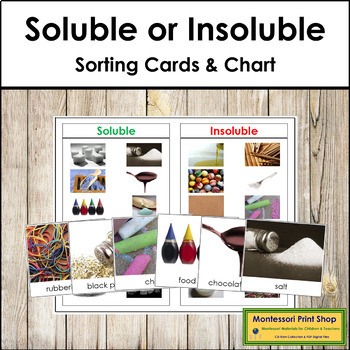
Soluble or Insoluble - Sorting Cards & Control Chart
Soluble or Insoluble Sorting Cards & Control Chart - Identify, sort, and classify substances that are either soluble or insoluble. Check the classification using the control chart.Includes:12 photo cards of soluble substances12 photo cards of insoluble substancestitle cards2 definition cards1 control chartPhoto cards are approx. 4" x 3¼".
Subjects:
Grades:
3rd - 5th
Types:
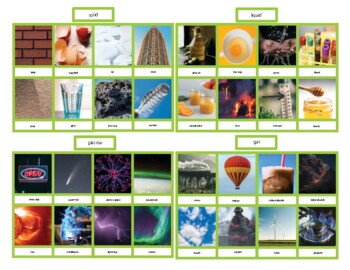
4 States of Matter Sorting Cards
Sorting cards for all four states of matter: plasma, solid, liquid and gas! Includes key for self-checking. Great introduction to chemistry!
Subjects:
Grades:
1st - 6th
Types:
Also included in: Four States of Matter Bundle

Montessori Periodic Table - Three/Four Part Cards
This PDF can be used to make a set of three/four part cards that can be used to teach students about the Periodic Table of Elements. Each term has a control card (word and picture), a word card, a picture card, and an information card. Topics included are: Periodic Table, elements, atomic number, period, group, and Dimitri Mendeleev. These cards are a favorite in my Lower El Montessori Classroom!
There is a FREE worksheet available in my shop that students can use as a simple quiz over the mate
Subjects:
Grades:
1st - 6th
Types:
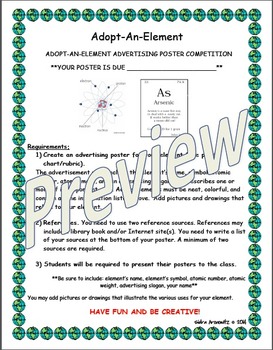
Adopt an Element Project Description and Rubric
This is a great project to include in a Chemistry unit. Students are required to select one of the elements from the Periodic table and complete a project including a poster and presentation. I have used this project with 2nd, 3rd and 4th graders.
Subjects:
Grades:
3rd - 6th
Types:
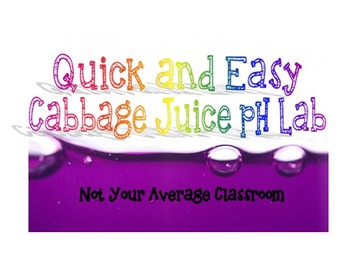
Quick and Easy Cabbage Juice pH Indicator Lab
This activity results in impressive color changes and is really fun to do! Students will use cabbage juice to test various substances for acidity or alkalinity. Purple cabbage juice turns bright pink for acids and bright blue for bases. This lab lists vinegar, tap water, baking soda solution, lemon/lime soda, and bleach solution - but you can easily convert the file to a word document and edit as needed.
This is a completely qualitative lab, and it is meant to be done in very little time. The ac
Subjects:
Grades:
5th - 12th
Types:
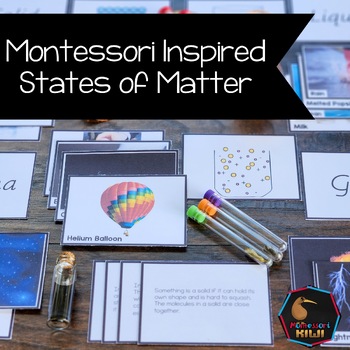
Solid, Liquid, Gas, Plasma - states of matter
This solid, liquid, gas and plasma sort is for you! It has a sorting activity -4 pictures for each state of matter-Solid, liquid, gas, plasma header card-Paragraph card Handwriting sheets (cursive and printing)Worksheet 20 pagesYou may also be interested in- Montessori Photosynthesis- Laws of the Universe Science Experiments- Montessori Inspired Compost Activities- Montessori Inspired Pollination Resource
Subjects:
Grades:
1st - 3rd
Types:
Also included in: Montessori Store Bundle

Hands-on Interactive Volcano Bundle Study: Types, Formation and Famous Volcanos
Create a science experiment of a real "erupting" volcano with a 3D model and step by step instructions. Learn about how volcanos form with a illustrated poster and learn about volcanos around the world with full color cards.*Photos may include completed items or display items not included. Please note this is ONLY for the digital copies of the resources used.
Subjects:
Grades:
PreK - 8th
Types:

Heat and Pressure
The ideal gas law describes the relationship between air pressure and temperature, which states that pressure is directly proportional to temperature. As temperature increases, so does air pressure, assuming all other variables remain constant. Conversely, as temperature decreases, air pressure also decreases. Pressure is the measurement of the number of collisions the gas molecules have with the container.The relationship between water pressure and temperature is generally as the temperature of
Subjects:
Grades:
Not Grade Specific
Types:

LAB Chemistry Density of Pennies - with Graphing & Demos
Engage your chemistry students by having them determine the composition of pennies as it changed over time. Students will chart & graph their results. After, you can demonstrate and prove that pennies are made of zinc internally.Included:3 page Student worksheet with procedure, chart, graph & analysis questions1 page teacher density demonstrations (5 easy options)Materials: pennies 13 pre 1982 & 13 post 1982 (per group or 1 set every two groups & switch pennies)graduated cylinder
Subjects:
Grades:
4th - 12th, Higher Education
Types:

Parts of an atom - Montessori nomenclature cards
This is a set of 3-part cards for the parts of an atom. Includes:- 6 photo cards - 6 labels- 6 description cards- 6 control cards- 1 cover card- 1 blackline master with 6 images for colouring Cut along the lines and you'll have a photo of each, a label to match it with, and a description, as well as a photo card and label together for children to check their work. I also included a page at the end for children to colour, label, and cut the pictures themselves.
Subjects:
Grades:
K - 3rd
Types:
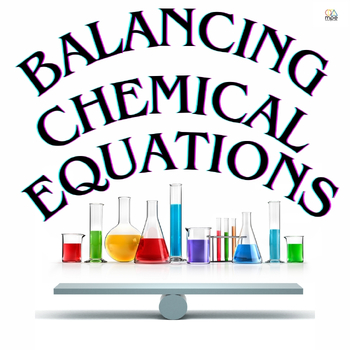
Balancing Chemical Equations
Introduction: Balancing chemical equations is a crucial skill in chemistry that involves adjusting the coefficients of reactants and products in a chemical equation to ensure that the number of atoms of each element on both sides of the equation is equal. This process is essential in understanding chemical reactions and predicting the outcome of a reaction. Balancing chemical equations is also helpful in real-life scenarios, such as industrial processes involving chemical reactions or environmen
Subjects:
Grades:
5th - 8th
Types:
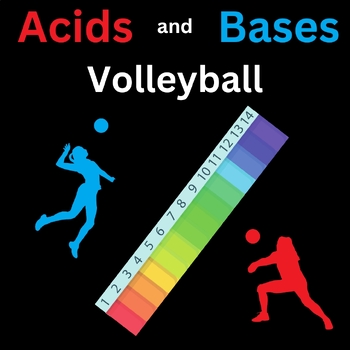
Acids and Bases Volleyball
What makes something acidic or basic? It all comes down to hydrogen. When we measure the acidity of alkalinity, we use the pH scale, which literally stands for the "potential of hydrogen." When we dissolve acids in water, we create excess hydrogen ions that are positively charged (H+). These hydrogen ions bind to water (H2O) to create hydronium (H3O+). The more hydronium present in the solution, the more acidic it is. Conversely, when we dissolve bases in water, we create excess negatively char
Subjects:
Grades:
5th - 8th
Types:

⚗️Chemical Reaction Science Experiment with ACTIVITY BOOK & LESSON PLAN
A quick introduction to chemical reaction. This mini-lesson includes a full lesson plan, teacher background, flashcards, an experiment guide, and a printable worksheet/workbook. This lesson is perfect for exploring the chemical reaction between baking soda and vinegar. Like this chemical reaction activity? Check out the chemistry unit to save 25% by clicking right here.Lesson Overview:Students will be introduced to chemicals and what chemical reactions are.Learn about the chemical reaction bet
Subjects:
Grades:
1st - 3rd
Types:
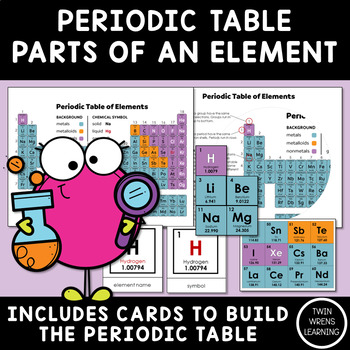
Periodic Table and Parts of an Element Three Part Cards
This resource will help your students learn about the parts of the periodic table and the elements.Students will learn what data is included on each element and how those elements are organized on the periodic table. They will also be able to build the periodic table by using the element cards that are included.What's included:Periodic table of elements control chartPeriodic table of elements blackline masters (two options: one with color legend and one without)Parts of the periodic table of ele
Subjects:
Grades:
2nd - 4th
Types:
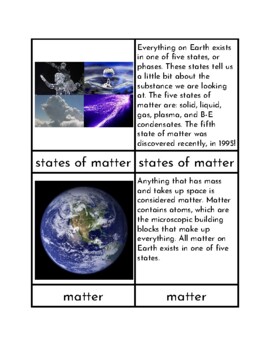
States of Matter - Three/Four Parts Cards with FREEBIE!
This PDF can be used to create a set of three or four part cards to teach children about the different states of matter. There is a picture card, word card, a picture and word card (control), and description card for each of the following terms: states of matter, matter, mass, volume, solid, liquid, gas, plasma, and B-E condensates. Included with this PDF is a simple set of sorting cards for solids, liquids, and gasses. This FREE activity is perfect for younger students who are just beginning to
Subjects:
Grades:
PreK - 6th
Types:
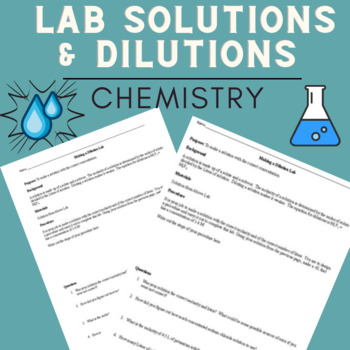
LAB - Chemistry - Make a Solution & Dilution - Easy Materials! - With KEY
This lab has students write their own procedure to make a solution and dilution with teacher observation & testing. This inquiry-STEM activity is great to get students thinking and engaged. Even some of the smartest students fail to connect Molarity to physical performance. This lab allows for that connection.I usually use a pH strip to test their solutions and dilutions! pH probe is better as well.materials:solute - the KEY is with citric acid, but any can be used.BalanceGraduated Cylinderb
Subjects:
Grades:
8th - 11th
Types:
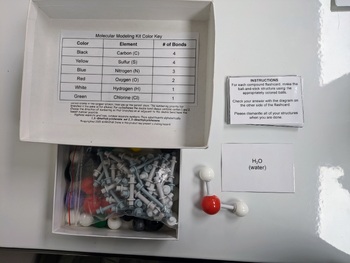
Covalent Bond Modeling Flashcards
Turn a molecular modeling kit into a classroom set of covalent bond practice!This document includes a color key for the balls in the kit, a set of 12 flashcards with molecule name on one side and the ball-and-stick model answer on the other, and an instruction card. I use this as Montessori shelfwork in my classroom.
Subjects:
Grades:
9th - 11th
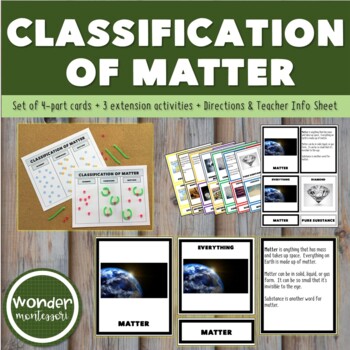
Classification of Matter Activities
Classification of Matter Activities This product includes Montessori 4-part cards PLUS 3 additional hands-on extension activities to reinforce this concept. The Classification of Matter activities would be introduced after students have had exposure to the basic definition of matter, states of matter, physical vs chemical properties, and basic intro to the Periodic Table. The 4-part cards include 10 key words (such as Matter, Solution, Compound, etc) with stunning images and clear text to exp
Subjects:
Grades:
3rd - 6th
Types:

Properties of Matter Sorting / Classification Cards, with Definitions
These sorting cards provide a fun, hands-on activity to help students practice their understanding of the properties of matter. Students match a definition card to each label heading, then check their answers. Next, they sort the cards below the headings, determining whether each property of matter is an extensive physical property, an intensive physical property, or a chemical property of matter. The set includes category labels, definition cards for matching to the labels, error control car
Subjects:
Grades:
5th - 9th
Types:
NGSS:
5-PS1-3
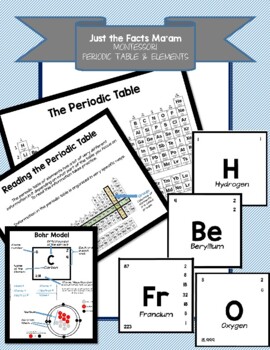
Periodic Table and Bohr Model cards w/ How-to-read explinations Great Lessons
Periodic Table of Elements and Element cards with electron shells listed for use with any chemistry curriculum or Montessori cultural geography curriculum. These cards can be used in concert with a Bohr element manipulative or drawing.
Subjects:
Grades:
1st - 6th
Types:
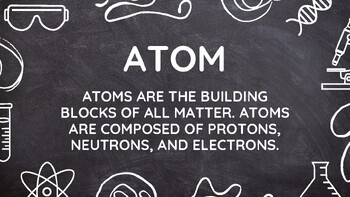
Bohr Board Label and Definition Cards
Definition and label cards for the elements necessary for a Bohr Board Activity. Includes labels and definitions for: atom, electron, neutron, proton, orbital, and nucleus.
Subjects:
Grades:
Not Grade Specific

Types of Clouds - Three/Four Part Cards
This PDF can be used to create a set of three or four part cards to teach children about 10 different types of clouds. There is a picture card, word card, a picture and word card (control), and description card for each of the following: clouds, cirrus, cirrocumulus, cirrostratus, altostratus, altocumulus, nimbostratus, stratus, stratocumulus, cumulus, and cumulonimbus.Be sure to check out my FREEBIE: Cloud Viewer - Cloud Identification WindowCards should be printed onto card stock, cut, and la
Subjects:
Grades:
PreK - 6th
Types:
5:50
Energy Balance Soccer
One of the hallmarks of understanding metabolism is the idea of “calories in, calories out,” which is the concept behind energy balance. While there is much more to understanding human nutrition, this is and will always be the foundation. The idea of energy balance is that the body uses a certain amount of calories daily for biological functions, exercise, growth, and repair. Energy requirements are met by consuming food. The balance of energy consumed and used is referred to as energy balance.
Subjects:
Grades:
Not Grade Specific
Types:
Also included in: Energy Balance Soccer Lesson Plan and Video
Showing 1-24 of 85 results





